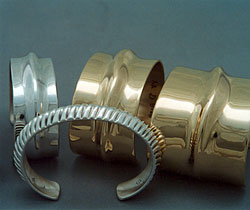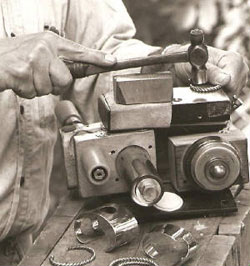Meet Metalsmith Henry Litchfield
 Wide Cuffs
Wide CuffsPhotograph courtesy of Henry Litchfield
Henry Litchfield's metalsmith career is a lot like one of his custom-fit copper bracelet cuffs: After following a few different job paths, this one fits him perfectly. "I always had a longtime interest in art," says Litchfield. "I had really wanted to be a painter or sculptor."
But, out of high school, Litchfield first went to aviation school and received his certificate to work as an aircraft mechanic. "But I didn't like working in a hangar," he says.
He then wore the sales hat, selling copy machines, computers and printing equipment door-to-door and climbing the corporate ladder as a sales manager for a few major companies from the 1960s to the 1980s. "But I didn't like that much either," he admits.
Litchfield decided to finally dabble in his artistic dream and designed a small line of metal jewelry. In 1990, he went full time selling the jewelry to galleries in the Midwest and at art fairs and shows held everywhere from his home base in Peoria, Il., to California.
He admits he's not a jeweler - more of a metalworker or blacksmith - and originally chose jewelry as an artistic medium because paintings or sculptures would have required a bigger vehicle than his Honda Accord when traveling to art shows. "I guess I still think very logistically or practically," he says.
Litchfield, 70, however, says he's always had a real appreciation for copper as a metal and its history in Native American weaponry and utensils. "It's such an integral part of our society now," he adds. "Copper is more important, industrially, than gold, which is used more for ornamentation. Plus copper is easy to work with. It's malleable and can be formed into a variety of shapes, and when you alloy it with tin or zinc, then it becomes bronze or brass so that adds to the 'machinability' or ductility of it."
 Using an anvil made from a discarded piece of railroad track and a ball peen hammer, the pieces are hammered or forged to shape.
Using an anvil made from a discarded piece of railroad track and a ball peen hammer, the pieces are hammered or forged to shape.Photograph courtesy of Henry Litchfield
Litchfield's jewelry line is anchored by his fluid-like bracelet cuffs, which are sized in ¼-inch increments to fit just about anyone's wrist. Bracelets in stainless steel, 14 karat gold, brass, copper, platinum or titanium are either shaped in a hydraulic press or by cold forging.
"Most of my work is done on an old anvil with a ball peen hammer," he explains. "I twist the metal then hammer it into shape."
He firmly believes in the health benefits of his copper bracelets, wearing one on each of his wrists - and a copper ring on his finger. Folklore says, since the human body has 24 elements, one of them being copper, if the body is lacking one of those elements, wearing copper would bring one's system back into balance. "Arthritis kept me from bending my finger before, and now I can bend it," says Litchfield, "so I know it works."
Although Litchfield has added a few star-moon earring designs, earrings out of old coins, pendants and key hooks, he says the bracelets are the breadwinners. "They're classic and simple, like the sign I hang up at shows that says 'Vanilla Bracelets.' Like vanilla ice cream, they go with anything," he says with a laugh. "So much jewelry is on the gaudy side now. It's like wearing a toaster on your wrist, which may be stylish now, but not tomorrow. People are still wearing my bracelets after 20 years or so."
Resources:
Also in this Issue:
- The Water Studio: The Alchemy of Copper, Fire and Water
- Ginny Ruffer: Finding Art in the Everyday
- Meet Metalsmith Henry Litchfield
- Sue Runyon Designs: Handcrafted Jewelry Inspired by Nature
- Tiffany Exhibit Makes the Only U.S. Stop in Richmond
